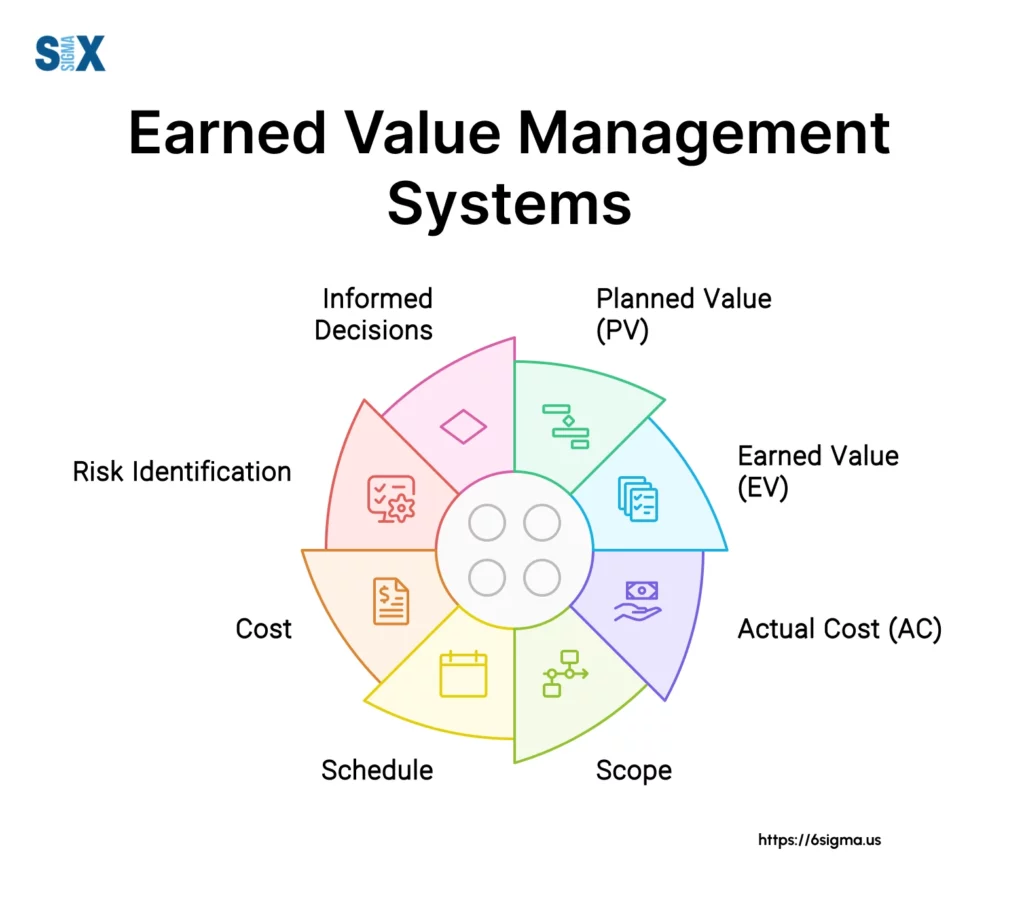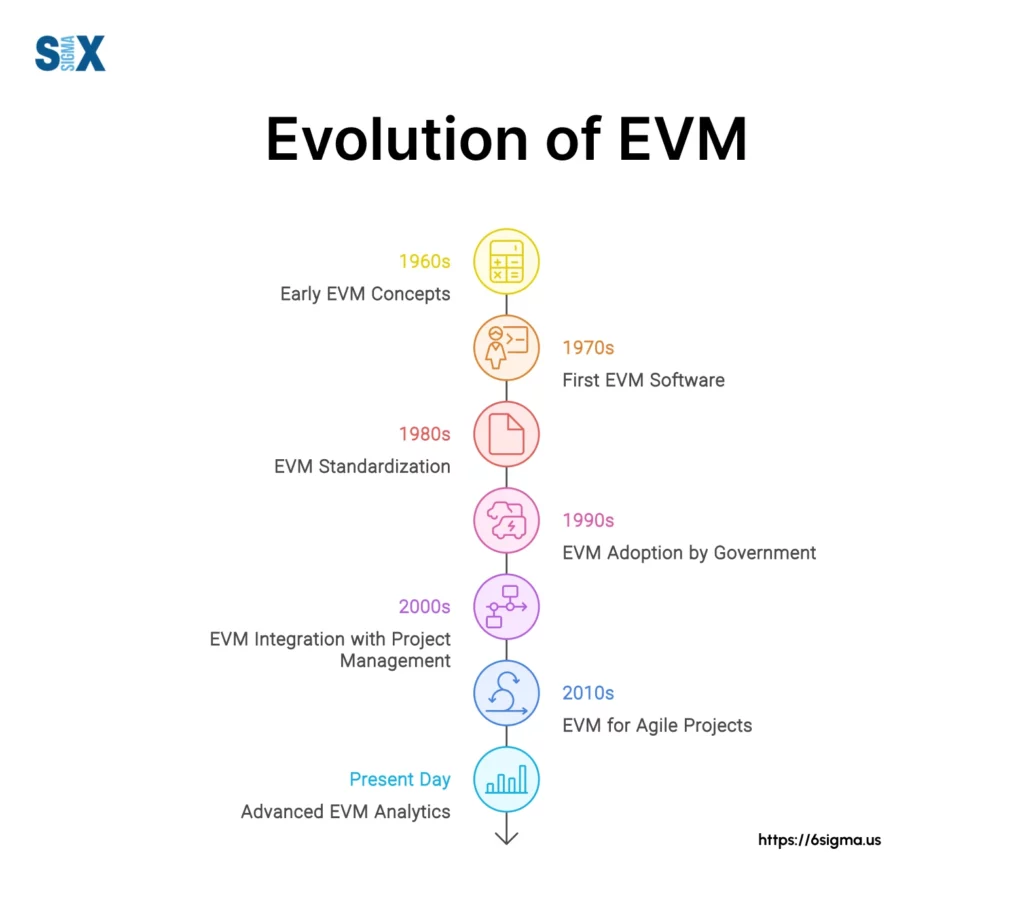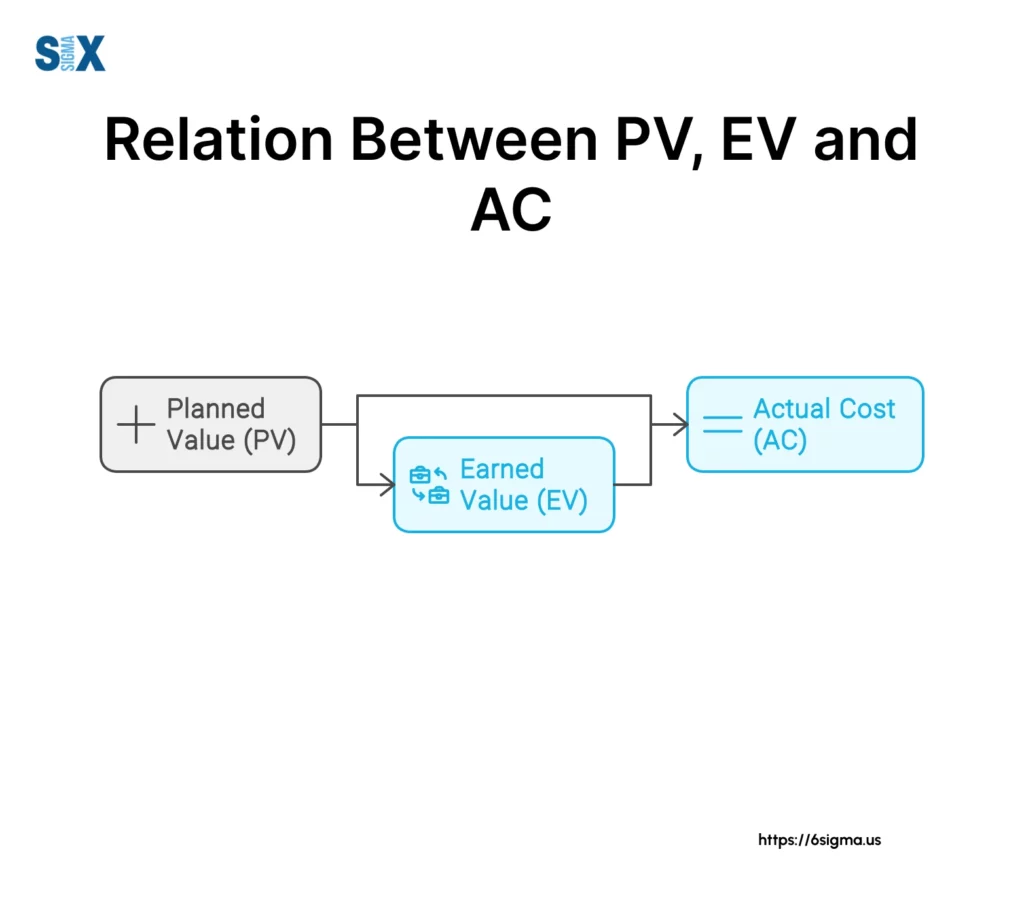Mastering Earned Value Management: Guide to Project Success
Earned Value Management (EVM), a project performance measurement technique, integrates scope, schedule, and cost to provide a comprehensive view of project health.
EVM is not just another management buzzword; it’s a robust methodology that has revolutionized how we track and forecast project performance.
Key Highlights
- Definition and historical development of Earned Value Management (EVM)
- Core components: PV, EV, and AC
- Essential metrics: CV, SV, CPI, and SPI
- Implementing EVMS: WBS, PMB, and IBR
- EVM in project control and risk management
- Advanced applications and best practices
- FAQs addressing common EVM queries
Introduction to Earned Value Management (EVM)
Earned Value Management (EVM) is like having a crystal ball for your projects.
It’s not just another buzzword; it’s a powerful tool that can make or break your project’s success.

Definition and Importance of Earned Value Management (EVM)
Earned Value Management is a project performance measurement technique that integrates scope, schedule, and cost.
It’s like having a financial health check-up for your project at any given moment. EVM allows you to answer three critical questions:
- Where have we been?
- Where are we now?
- Where are we going?
The importance of Earned Value Management can’t be overstated. It provides an early warning system for potential issues, enables accurate forecasting, and promotes accountability.
In my experience, projects that implement EVM have a higher success rate and are more likely to be delivered on time and within budget.
Historical Development of Earned Value Management
EVM isn’t a new kid on the block. Its roots can be traced back to the 1960s when the U.S. Department of Defense developed the Cost/Schedule Control Systems Criteria (C/SCSC).
Over time, it evolved into what we now know as Earned Value Management.
In the 1990s, the American National Standards Institute (ANSI) and the Electronic Industries Alliance (EIA) developed these into 32 guidelines for EVMS, resulting in the ANSI/EIA 748 standard.
This standard has become the gold standard for many government agencies and large corporations.

Key Components of Earned Value Management
Now, these are the nuts and bolts of Earned Value Management.
There are three key components that form the foundation of this technique.
Planned Value (PV) and Budgeted Cost of Work Scheduled (BCWS)
Planned Value, also known as Budgeted Cost of Work Scheduled (BCWS), is your roadmap.
It’s the approved budget for the work scheduled to be completed by a specific date. Think of it as your project’s financial GPS.
For example, if you’re building a house and you’ve budgeted $50,000 for the foundation to be completed in the first month, that $50,000 is your Planned Value for that period.
Earned Value (EV) and Budgeted Cost of Work Performed (BCWP)
Earned Value, or Budgeted Cost of Work Performed (BCWP), is where the rubber meets the road. It’s the value of the work actually completed, expressed in terms of the approved budget.
Sticking with our house-building example, if you’ve completed 80% of the foundation work, your Earned Value would be $40,000 (80% of $50,000).
Actual Cost (AC) and Actual Cost of Work Performed (ACWP)
Actual Cost, or Actual Cost of Work Performed (ACWP), is exactly what it sounds like – the real costs incurred for the work completed. This includes all the resources expended, be it time, money, or materials.
If you’ve spent $45,000 on that 80% completed foundation, that’s your Actual Cost.

Earned Value Management Metrics and Performance Indicators
See how we can use the key components of EVM to gauge our project’s performance.
Cost Variance (CV) and Schedule Variance (SV)
Cost Variance (CV) and Schedule Variance (SV) are like your project’s report card. They tell you how you’re doing in terms of cost and schedule.
CV = EV – AC
SV = EV – PV
In our house-building scenario:
CV = $40,000 – $45,000 = -$5,000 (We’re over budget)
SV = $40,000 – $50,000 = -$10,000 (We’re behind schedule)
Cost Performance Index (CPI) and Schedule Performance Index (SPI)
CPI and SPI are efficiency indicators. They tell you how efficiently you’re using your resources.
CPI = EV / AC
SPI = EV / PV
For our house:
CPI = $40,000 / $45,000 = 0.89 (We’re getting $0.89 worth of work for every dollar spent)
SPI = $40,000 / $50,000 = 0.80 (We’re progressing at 80% of the planned rate)
Estimate at Completion (EAC) and Estimate to Complete (ETC)
EAC and ETC are your crystal ball. They help you forecast the future of your project.
EAC = BAC / CPI (where BAC is Budget at Completion)
ETC = EAC – AC
If our total house budget (BAC) is $500,000:
EAC = $500,000 / 0.89 = $561,798 (We’re forecasted to overspend)
ETC = $561,798 – $45,000 = $516,798 (This is how much more we expect to spend)
Implementing Earned Value Management Systems (EVMS)
Implementing EVMS isn’t a walk in the park, but the benefits far outweigh the effort. Let’s break it down.
Work Breakdown Structure (WBS) and Project Scheduling with Earned Value Management (EVM)
The Work Breakdown Structure is the backbone of your project. It’s a hierarchical decomposition of the total scope of work.
Paired with a solid project schedule, it forms the foundation of your EVMS.
Establishing the Performance Measurement Baseline (PMB)
The Performance Measurement Baseline is your yardstick. It’s the time-phased budget plan against which project performance is measured.
It’s crucial to get this right, as all your measurements will be compared against this baseline.
Integrated Baseline Review (IBR) process with Earned Value Management (EVM)
The Integrated Baseline Review is like a pre-flight check. It’s a joint assessment of the PMB to ensure it’s realistic and achievable.
This process helps identify and mitigate risks before they become issues.
Earned Value Management in Project Control and Monitoring
EVM shines brightest when it comes to project control and monitoring. It’s like having a control tower for your project.
Variance Analysis and Forecasting Techniques
Variance analysis helps you understand why your project is deviating from the plan. Are you over budget because of unexpected material costs?
Are you behind schedule due to resource constraints? EVM helps you pinpoint these issues.
Progress Reporting and Performance Indicators
EVM provides objective performance indicators that can be easily communicated to stakeholders.
No more subjective “percent complete” estimates – Earned Value Management gives you hard numbers to back up your progress reports.
Risk Management Integration With Earned Value Management
EVM and risk management go hand in hand. EVM helps identify risks early, while risk management helps you prepare for potential EVM deviations.
It’s a symbiotic relationship that enhances your project control.
Advanced Earned Value Management (EVM) Applications and Best Practices
Once you’ve mastered the basics, there’s a whole world of advanced EVM applications to explore.
Critical Path Analysis in Earned Value Management
Combining EVM with critical path analysis gives you a powerful tool for managing your project’s timeline.
It helps you focus your efforts where they’ll have the most impact on your schedule performance.
Resource Allocation and Productivity Measurement
EVM can help you optimize your resource allocation by showing you where you’re getting the most bang for your buck. It also provides objective measures of productivity, helping you identify high-performing teams and processes.
Cost-schedule Integration Strategies
Advanced EVM users can develop sophisticated strategies for integrating cost and schedule management.
This holistic approach can lead to more accurate forecasts and better project outcomes.
Some Pros and Cons of Earned Value Management (EVM)
Like any tool, EVM has its strengths and weaknesses. On the plus side, it provides objective performance measurement, early warning of issues, and accurate forecasting.
On the downside, it can be complex to implement, requires discipline to maintain, and may not be suitable for all types of projects.
FAQs
A. The core principles of EVM are:
– Plan all work scope for the project
– Break down the project work scope into finite pieces that can be assigned to a responsible person or organization for control of technical, schedule and cost objectives
– Integrate project work scope, schedule, and cost objectives into a performance measurement baseline plan against which accomplishments may be measured
– Use actual costs incurred and recorded in accomplishing the work performed
– Objectively assess accomplishments at the work performance level
– Analyze significant variances from the plan, forecast impacts, and prepare an estimate at completion based on performance to date and work to be performed
A. EVM is calculated using three primary measurements:
Planned Value (PV) = Budgeted Cost of Work Scheduled
Earned Value (EV) = Budgeted Cost of Work Performed
Actual Cost (AC) = Actual Cost of Work Performed
These measurements are then used to calculate various performance indices and variance
A. The primary goal of Earned Value Management (EVM) is to provide an objective measure of project performance and progress. It aims to improve project management by providing early warning of performance problems, enabling better decision-making, and increasing the likelihood of project success.
A. The 50/50 rule is a method for calculating Earned Value on in-progress work. It assigns 50% of the budget value when a task starts and the remaining 50% when it’s completed. This rule is often used for short-duration tasks where more precise progress measurement isn’t practical.
A. Earned Value Management (EVM) is useful because it provides:
– An objective measure of project performance
– Early warning of potential issues
– Accurate forecasting of project costs and completion dates
– A common language for discussing project progress
– Accountability for project performance
– A basis for data-driven decision-making in project management
SixSigma.us offers both Live Virtual classes as well as Online Self-Paced training. Most option includes access to the same great Master Black Belt instructors that teach our World Class in-person sessions. Sign-up today!
Virtual Classroom Training Programs Self-Paced Online Training Programs






